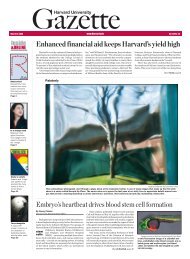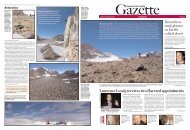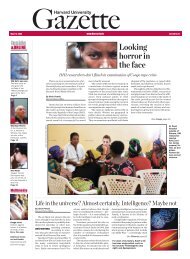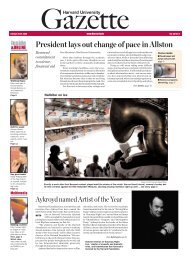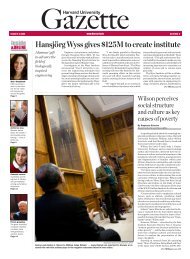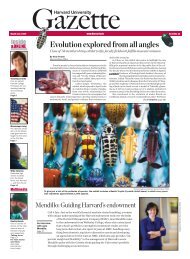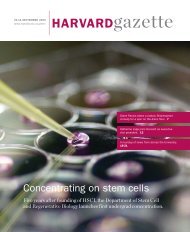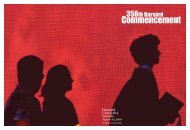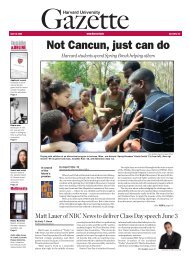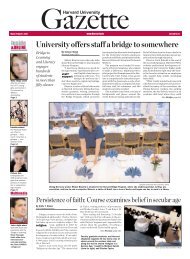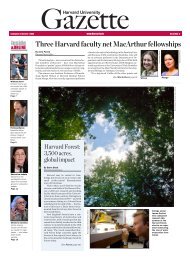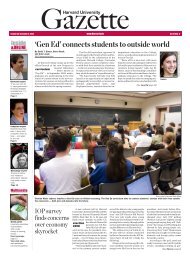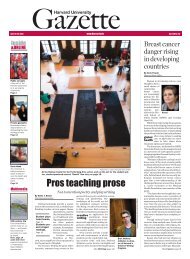Harvard University Gazette December 4-10, 2008 - Harvard News ...
Harvard University Gazette December 4-10, 2008 - Harvard News ...
Harvard University Gazette December 4-10, 2008 - Harvard News ...
Create successful ePaper yourself
Turn your PDF publications into a flip-book with our unique Google optimized e-Paper software.
<strong>December</strong> 4-<strong>10</strong>, <strong>2008</strong> <strong>Harvard</strong> <strong>University</strong> <strong>Gazette</strong>/ 11<br />
Woolsey: New<br />
technologies<br />
will make need<br />
for oil obsolete<br />
By Holly Metter<br />
FAS Communications<br />
Photos Stephanie Mitchell/<strong>Harvard</strong> <strong>News</strong> Office<br />
In the pursuit of new materials, Aizenberg and her lab partners have synthesized hairlike bundles, shown here hugging<br />
a bead. The hairs are one-hundredth as wide as a human hair.<br />
Scientists explore nature’s designs<br />
Physical chemist Joanna Aizenberg<br />
imitates structures found in nature<br />
By Corydon Ireland<br />
<strong>Harvard</strong> <strong>News</strong> Office<br />
As a graduate student, <strong>Harvard</strong> physical chemist<br />
Joanna Aizenberg acquired a passionate curiosity<br />
about — of all things — sponges. She particularly liked<br />
the ones made of glass, whose apparent fragility belied<br />
the fact that they could withstand terrific pressure<br />
in the deep sea.<br />
Sponges are now among the central artifacts<br />
in an emerging branch of science<br />
Aizenberg is helping to pioneer: biomimetics. That’s<br />
the study of whatever nature does well — and how that<br />
may inspire better tools, materials, and processes.<br />
Aizenberg is particularly interested in how living<br />
organisms form robust and elegant inorganic struc-<br />
materials<br />
science<br />
tures. The glass fibers framing those deep-sea<br />
sponges, for instance, are stronger and more optically<br />
efficient than anything humankind can yet make.<br />
She outlined the nature of her work in an abundantly<br />
illustrated lecture Nov. 19 at the Radcliffe<br />
Gymnasium, “Connecting Engineering, Physics,<br />
Chemistry, Biology, and Architecture Through Biomimetics.”<br />
Aizenberg — a trained mathematician and chemist<br />
who earned a doctorate in the biology of materials —<br />
has the chops to connect all those disciplines. She is<br />
the Gordon McKay Professor of Materials Science at<br />
the <strong>Harvard</strong> School of Engineering and Applied Sciences<br />
(SEAS) and the Susan S. and Kenneth L. Wallach<br />
Professor at the Radcliffe Institute for Advanced<br />
Study, where she is a fellow this year.<br />
To illustrate the kind of work done at her SEAS laboratory,<br />
Aizenberg focused on Venus’ Flower Basket,<br />
a milky-looking undulant sponge shaped like a tapering<br />
tube. Though common in hobbyist’s aquariums,<br />
it is native to the deep ocean, thriving in cold,<br />
crushing pressures a thousand feet below the surface.<br />
For materials scientists like Aizenberg, Venus’<br />
Flower Basket is an intriguing package. At 500 million<br />
years old, it’s very low on the evolutionary tree.<br />
But its layered superstructure of glass illustrates how<br />
strong nature makes things, and with what apparent<br />
ease.<br />
The first commercially practical glass fibers were<br />
not invented until the 1930s, said Aizenberg, yet<br />
“sponges knew how to do it a half-billion years ago.”<br />
And they knew how to do it better, she pointed out.<br />
The glass fibers of Venus’ Flower Basket are a hundred<br />
times stronger than the man-made version. Intricately<br />
layered, and reinforced with a still-mysteri-<br />
(See Aizenberg, next page)<br />
Aizenberg is helping to<br />
pioneer an emerging<br />
branch of science: biomimetics.<br />
That’s the<br />
study of whatever nature<br />
does well — and<br />
how that may inspire<br />
better tools, materials,<br />
and processes.<br />
Salt was once highly valued as a<br />
preservative for meat, but eventually a<br />
new technology — refrigeration —<br />
greatly reduced its value. Today, rather<br />
than a contentious commodity, salt is a<br />
humdrum condiment.<br />
Energy expert James Woolsey told a<br />
<strong>Harvard</strong> audience on Nov. 19 that we<br />
must strive to make oil as boring as table<br />
future of<br />
energy<br />
salt. How Through<br />
dramatic new technologies<br />
that will obviate oil<br />
much as refrigeration cut demand for<br />
salt.<br />
Woolsey, director of the Central Intelligence<br />
Agency from 1993 to 1995 and<br />
now a partner with California-based<br />
VantagePoint Venture Partners, spoke<br />
to a full lecture hall in the Science Center<br />
about “Energy, Security and the<br />
Long War of the 21st Century.” His address<br />
was part of a lecture series on the<br />
future of energy, hosted by the <strong>Harvard</strong><br />
<strong>University</strong> Center for the Environment.<br />
After a lighthearted biographical<br />
sketch (Rhodes Scholar at Oxford, Yale<br />
Law, service in the military and in a variety<br />
of government and advisory roles),<br />
Nick Welles/<strong>Harvard</strong> <strong>News</strong> Office<br />
Former CIA director James Woolsey delivers<br />
his talk on ‘Energy, Security and the<br />
Long War of the 21st Century.’<br />
Woolsey explored the national security<br />
implications of a shift away from fossil<br />
fuels, differentiating between “malignant<br />
problems” and “malevolent<br />
threats.”<br />
Malignant problems, he said, occur<br />
when a random accident disturbs a<br />
complex system. In August 2003, three<br />
branches tangled with power lines in<br />
Cleveland; nine seconds later, 80 gigawatts<br />
— equivalent to the wattage<br />
produced by 80 nuclear power plants —<br />
was offline across the northeastern<br />
United States, leaving millions of people<br />
in the dark.<br />
As an analogy for the nation’s fragile,<br />
(See Woolsey, next page)



